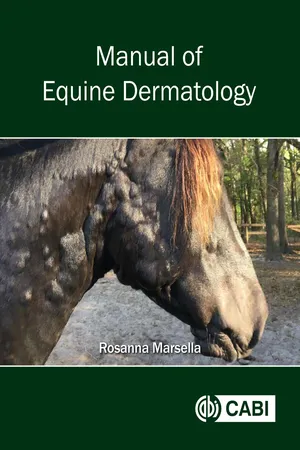![]()
1 Approach to a Dermatological Case
Dermatological cases are common in clinical practice and can be frustrating and challenging for a variety of reasons. The most common challenge is that many diseases look alike once the initial primary lesions are replaced by secondary and less specific lesions. Taking a history is helpful to understand how the disease looked originally compared with how it presents at the time of evaluation.
Another challenge in dermatology is that the majority of cases present with some form of secondary infections and a level of pruritus. It is helpful to know whether the disease started with pruritus or whether the pruritus developed later in order to discriminate whether the itch is primary or not. It is also important to know whether the lesions were present at the very beginning or the eruption came later, or if the skin lesions are simply the result of self-trauma. All of these considerations can greatly change how the case is approached and whether a correct diagnosis is achieved or not.
The challenge for the clinician, therefore, is to separate primary from secondary symptoms and to determine what started first and what developed later. The clinician should strive to identify, if possible, the primary lesions and their distribution. Equally important is to address the secondary infections and then re-evaluate the type of lesion and pruritus that is still present to determine whether the pruritus is due to infections or to the primary underlying disease.
From the clinical standpoint, it is helpful to consider a problem-based approach when considering differential diagnoses for a dermatology patient. Once the primary lesions and their distribution have been identified, diseases that present with these lesions can be considered and ranked, based on the rest of the history. A diagnostic plan can be made to rule in or out the various differential diagnoses. The purpose of this book is to provide a problem-based approach rather than presenting diseases based on etiology or pathogenesis.
History and Signalment
When evaluating a dermatology patient, the history is crucial, as many diseases can be differentiated based on the history. One example of how the history can help discriminate among differential diagnoses is that of a horse presenting with a highly pruritic hemorrhagic lesion on its pastern in the south-eastern USA in the summer. This horse could be considered for both pythiosis (caused by Pythium insidiosum) and habronemiasis (caused by Habronema spp.). Both diseases are highly pruritic and can present with white hard granules in the exudate, commonly described as kunkers, and have many eosinophils on cytology. The course of these two diseases, however, is very different and so is the prognosis. While habronemiasis has a slow course and the patient may have had a previous history of recurrent summer sores that get better in the winter and reoccur the following summer, the pythiosis patient has a fast progression of disease that does not get better with the change of season. Knowing the speed of progression, whether the animal has had similar lesions before and the exposure to standing water can greatly help to differentiate between these two diseases, allowing a prompt diagnosis, the correct treatment, and an accurate prognosis.
Another example is a 10-year-old Warmblood horse presenting with the complaint of severe head and neck pruritus in the fall in Florida, with no prior history of pruritus reported by the owner. Allergies typically occur in young individuals but, typically, do not wait 10 years to manifest themselves in a place like Florida, so other differentials such as parasites or systemic disease should be considered. Crucial, however, is the fact that this horse lived for the first 9 years of its life in New York State and relocated to Florida only a few months ago. Thus, it is very likely that it could have allergies, possibly to Culicoides spp. midges, and that this is likely to be the cause of the severe pruritus in the fall.
Signalment (age, breed and sex) can help with the ranking of differential diagnoses, as some diseases are more likely to occur in the young or the elderly (e.g. dermatophytosis), while others are typical of middle-aged animals (e.g. autoimmune diseases), although exceptions are always possible. Some diseases may have a different prognosis depending on the age of the patient. For example, pemphigus foliaceus occurring in foals, typically carries a better prognosis than when it occurs in middle-aged or older horses.
Taking note of the breed can also help with the index of suspicion about certain diseases, although this information should not be extrapolated to create ‘clinical blinders’. For example, draft horses are more prone to Chorioptes infestations than other breeds due to the presence of feathers. However, this does not mean that a pustular eruption present on the coronary band of a draft horse should automatically be assumed to be due to Chorioptes mites. It may very well be pemphigus foliaceus in a draft horse. Therefore, it is important to consider the presence (or not) of pruritus and to perform the appropriate tests (e.g. cytology to detect acantholytic cells) and to carry out skin scrapings to detect Chorioptes spp. to rule in or rule out differential diagnoses.
The history provides the clinician with important clues on where to focus during the physical examination and how to rank differential diagnoses. While some questions are standard, others may be based on the level...
